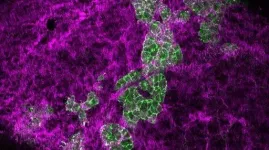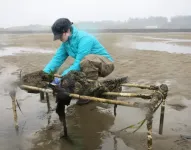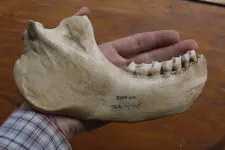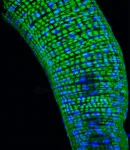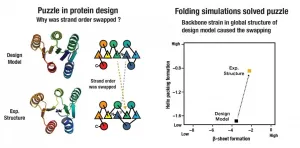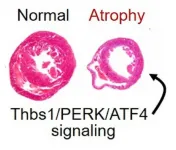INFORMATION:
This research was made possible by generous philanthropic support of the Wolf family and Prof Richard Epstein.
The Australian Genomic Cancer Medicine Program (Omico Ltd) is funded by the Office for Health and Medical Research, State of New South Wales and Australian Federal Government, and acknowledges support from Roche for contributing to the Molecular Screening and Therapeutic (MoST) trial. David Thomas is supported by the National Health and Medical Research Council (NHMRC) Principal Research Fellowship.
Precision medicine becomes more accessible for Australians with cancer
Garvan researchers launch new tool to inform targeted cancer treatment options
2021-06-24
(Press-News.org) A new resource developed at the Garvan Institute of Medical Research and The Kinghorn Cancer Centre for oncologists could help make targeted cancer therapies more accessible for Australian patients.
The TOPOGRAPH (Therapy-Oriented Precision Oncology Guidelines for Recommending Anti-cancer Pharmaceuticals) database is an online tool that catalogues oncology research to streamline the process of recommending therapeutic treatments in precision cancer medicine.
Garvan Senior Research Officer Dr Frank Lin led the development of the platform reported this week in the journal npj Precision Oncology.
"TOPOGRAPH is uniquely useful in the Australian context because it combines up-to-date information on treatments approved for use in Australia in both clinical and trial settings," Dr Lin says. "This tool was designed to systematically organise the vast amount of data from clinical trials and regulatory authorities into an accessible, easy to use platform for oncologists to maximise the therapeutic benefit to patients."
Bringing the data together
While several resources exist that interpret the potential therapeutic significance of genomic variations and other biomarkers in cancer, a number of factors such as government subsidies and approvals by national regulators can limit access to treatments.
Dr Lin says that in Australia, there was a strong need for a "pragmatic, evidence-based, context-adapted tool to guide clinical management based on molecular biomarkers".
"We designed this tool because there's no good alternatives in Australia to help oncologists sieve through potential treatment options when facing a complex genomic report."
The TOPOGRAPH team, which included researchers from the Garvan Institute, The Kinghorn Cancer Centre, St Vincent's Hospital, Australian Genomic Cancer Medicine Program (Omico), UNSW Sydney, The University of Sydney and the NHMRC Clinical Trials Centre, conducted a comprehensive literature review and appraisal to develop a database comprising 211 predictive biomarkers, 117 cancer types and more than 400 therapies.
Oncologists can look up any of these parameters on the platform, as well as combinations of biomarkers, cancer types, and therapies to view information tailored for patients with advanced cancer.
Therapies are organised into different tiers according to how effective they have been shown to be for a given cancer based on key biomarkers, its approval for use in Australia, and whether the cost of the treatment can be subsidised through the pharmaceutical benefits scheme (PBS).
Dr Subo Thavaneswaran, Medical Oncologist at The Kinghorn Cancer Centre and Garvan researcher, says the database is already proving useful in a clinical setting.
"Applying TOPOGRAPH to our Molecular Tumour Board recommendations at The Kinghorn Cancer Centre gives us greater confidence in their consistency, evidence-base and understanding of accessibility to therapies in the Australian context."
Emerging research
One of the reasons TOPOGRAPH was built was to keep oncologists up to date with the latest research and treatment approvals. The researchers plan to update TOPOGRAPH with treatments and therapies as they emerge and undergo assessment by the Therapeutic Goods Administration.
Professor David Thomas, senior author of the paper and Head of the Genomic Cancer Medicine Laboratory at Garvan, Director of The Kinghorn Cancer Centre and CEO of Omico, says that TOPOGRAPH could also be expanded to other jurisdictions by adjusting the platform's tier system.
"While this paper describes the use of TOPOGRAPH in the Australian context, our approach can be applied as a framework to other jurisdictions and the guidelines of different regulatory bodies. From a global oncology perspective, comparing tiered therapies between countries may help identify differences in equity of access by highlighting the disparity in drug utilisation compared to scientific advances in cancer therapeutics," he says.
"In addition, there is a potential role for TOPOGRAPH to support translational research, by informing the design of new correlative studies to explore more precise biomarkers for targeted therapies."
ELSE PRESS RELEASES FROM THIS DATE:
PSU study finds chemicals from human activities in transplanted oysters far from population centers
2021-06-24
Wastewater treatment facilities clean the water that goes down our sinks and flushes our toilets, but they do not remove everything. A recent study by Portland State researchers detected low levels of pharmaceuticals and personal care product chemicals in oysters the team deployed at various distances from wastewater effluent pipes along the Oregon and Washington coast. Elise Granek, professor of environmental science and management at Portland State University, and Amy Ehrhart, a recent graduate of PSU's Earth, Environment, and Society doctoral program, conducted the study.
To explore how aquatic pollution varies based on proximity to wastewater facilities, Ehrhart and Granek placed one-week-old ...
A detailed atlas of the developing brain
2021-06-24
Researchers at Harvard University and the Broad Institute of MIT and Harvard have created a first detailed atlas of a critical region of the developing mouse brain, applying multiple advanced genomic technologies to the part of the cerebral cortex that is responsible for processing sensation from the body. By measuring how gene activity and regulation change over time, researchers now have a better understanding of how the cerebral cortex is built, as well as a brand new set of tools to explore how the cortex is affected in neurodevelopmental disease. The study is published in the journal Nature.
"We have had a long-standing interest in understanding the development of the mammalian cerebral cortex, as it is ...
Newly sequenced genome of extinct giant lemur sheds light on animal's biology
2021-06-24
UNIVERSITY PARK, Pa. -- Using an unusually well-preserved subfossil jawbone, a team of researchers -- led by Penn State and with a multi-national team of collaborators including scientists from the Université d'Antananarivo in Madagascar -- has sequenced for the first time the nuclear genome of the koala lemur (Megaladapis edwardsi), one of the largest of the 17 or so giant lemur species that went extinct on the island of Madagascar between about 500 and 2,000 years ago. The findings reveal new information about this animal's position on the primate family tree and how it interacted with its environment, which could help in understanding the impacts of past lemur extinctions on Madagascar's ecosystems.
"More than 100 species of lemurs live on Madagascar today, ...
Study suggests scientists may need to rethink which genes control aging
2021-06-24
To better understand the role of bacteria in health and disease, National Institutes of Health researchers fed fruit flies antibiotics and monitored the lifetime activity of hundreds of genes that scientists have traditionally thought control aging. To their surprise, the antibiotics not only extended the lives of the flies but also dramatically changed the activity of many of these genes. Their results suggested that only about 30% of the genes traditionally associated with aging set an animal's internal clock while the rest reflect the body's response to bacteria.
"For ...
Throwing shade: Measuring how much trees, buildings cool cities
2021-06-24
COLUMBUS, Ohio - When the summer sun blazes on a hot city street, our first reaction is to flee to a shady spot protected by a building or tree.
A new study is the first to calculate exactly how much these shaded areas help lower the temperature and reduce the "urban heat island" effect.
Researchers created an intricate 3D digital model of a section of Columbus and determined what effect the shade of the buildings and trees in the area had on land surface temperatures over the course of one hour on one summer day.
"We can use the information from our model to formulate guidelines for community greening and tree planting efforts, and even where to locate buildings to maximize shading on other buildings and roadways," said Jean-Michel Guldmann, co-author of the study and ...
Water vole genome will help boost conservation of one of UK's most endangered mammals
2021-06-24
A new tool to help conserve one of the UK's most threatened mammals has been released today, with the publication of the first high-quality reference genome for the European water vole. The genome was generated by scientists at the Wellcome Sanger Institute, in collaboration with animal conservation charity the Wildwood Trust, as part of the Darwin Tree of Life Project.
The genome, published today (24 June 2021) through Wellcome Open Research, is openly available as a reference for researchers seeking to assess water vole population genetics, better understand how the species has evolved and to manage reintroduction efforts.
The European water vole (Arvicola ...
Researchers solve a puzzle to design larger proteins
2021-06-24
A team from Japan and the United States has identified the design principles for creating large "ideal" proteins from scratch, paving the way for the design of proteins with new biochemical functions.
Their results appear June 24, 2021, in Nature Communications.
The team had previously developed principles to design small versions of what they call "ideal proteins," which are structures without internal energetic frustration.
Such proteins are typically designed with a molecular feature called beta strands, which serve a key structural role for the molecules. In ...
Antarctic Circumpolar Current flows more rapidly in warm phases
2021-06-24
Our planet's strongest ocean current, which circulates around Antarctica, plays a major role in determining the transport of heat, salt and nutrients in the ocean. An international research team led by the Alfred Wegener Institute has now evaluated sediment samples from the Drake Passage. Their findings: during the last interglacial period, the water flowed more rapidly than it does today. This could be a blueprint for the future and have global consequences. For example, the Southern Ocean's capacity to absorb CO2 could decrease, which would in turn intensify climate change. The study has now been published in the journal Nature Communications.
The Antarctic Circumpolar Current (ACC) is the world's strongest ocean ...
New knowledge of Earth's mantle helps to explain Indonesia's explosive volcanoes
2021-06-24
Indonesia's volcanoes are among the world's most dangerous. Why? Through chemical analyses of tiny minerals in lava from Bali and Java, researchers from Uppsala University and elsewhere have found new clues. They now understand better how the Earth's mantle is composed in that particular region and how the magma changes before an eruption. The study is published in Nature Communications.
Frances Deegan, the study's first author and a researcher at Uppsala University's Department of Earth Sciences, summarises the findings.
"Magma is formed in the mantle, and the composition of the mantle under Indonesia used to be only partly known. ...
Cardiac atrophy findings may set course for preventing harm from long space flights
2021-06-24
In many situations, heart muscle cells do not respond to external stresses in the same ways that skeletal muscle cells do. But under some conditions, heart and skeletal muscles can both waste away at fatally rapid rates, according to a new study led by experts at Cincinnati Children's.
The new findings, based on studies of mouse models, represent an important milestone in a long effort to prevent or even reverse cardiac atrophy, which can lead to fatal heart failure when the body loses large amounts of weight or experiences extended periods of weightlessness in space. Detailed findings were published online June 24, 2021, in Nature Communications.
"NASA is very interested in cardiac atrophy," says Jeffery Molkentin, PhD, Co-Director ...
LAST 30 PRESS RELEASES:
Numbers in our sights affect how we perceive space
SIMJ announces global collaborative book project in commemoration of its 75th anniversary
Air pollution exposure and birth weight
Obstructive sleep apnea risk and mental health conditions among older adults
How talking slows eye movements behind the wheel
The Ceramic Society of Japan’s Oxoate Ceramics Research Association launches new international book project
Heart-brain connection: international study reveals the role of the vagus nerve in keeping the heart young
Researchers identify Rb1 as a predictive biomarker for a new therapeutic strategy in some breast cancers
Survey reveals ethical gaps slowing AI adoption in pediatric surgery
Stimulant ADHD medications work differently than thought
AI overestimates how smart people are, according to HSE economists
HSE researchers create genome-wide map of quadruplexes
Scientists boost cell "powerhouses" to burn more calories
Automatic label checking: The missing step in making reliable medical AI
Low daily alcohol intake linked to 50% heightened mouth cancer risk in India
American Meteorological Society announces Rick Spinrad as 2026 President-Elect
Biomass-based carbon capture spotlighted in newly released global climate webinar recording
Illuminating invisible nano pollutants: advanced bioimaging tracks the full journey of emerging nanoscale contaminants in living systems
How does age affect recovery from spinal cord injury?
Novel AI tool offers prognosis for patients with head and neck cancer
Fathers’ microplastic exposure tied to their children’s metabolic problems
Research validates laboratory model for studying high-grade serous ovarian cancer
SIR 2026 delivers transformative breakthroughs in minimally invasive medicine to improve patient care
Stem Cell Reports most downloaded papers of 2025 highlight the breadth and impact of stem cell research
Oxford-led study estimates NHS spends around 3% of its primary and secondary care budget on the health impacts of heat and cold in England
A researcher’s long quest leads to a smart composite breakthrough
Urban wild bees act as “microbial sensors” of city health.
New study finds where you live affects recovery after a hip fracture
Forecasting the impact of fully automated vehicle adoption on US road traffic injuries
Alcohol-related hospitalizations from 2016 to 2022
[Press-News.org] Precision medicine becomes more accessible for Australians with cancerGarvan researchers launch new tool to inform targeted cancer treatment options
